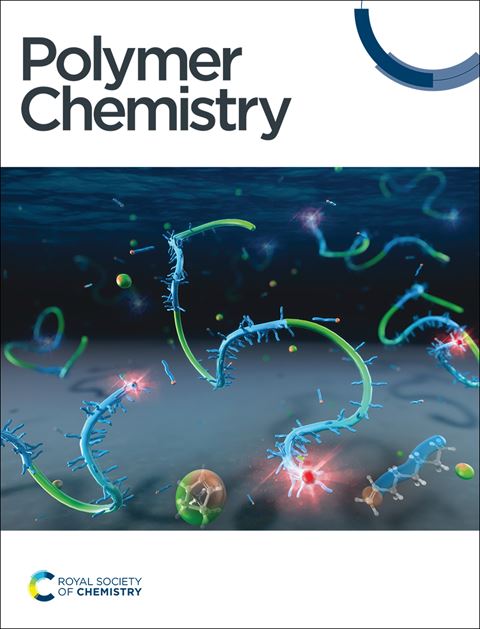机械化学氧化聚合法制备聚(3,4-丙基二氧噻吩)(PProDOT)类似物
IF 4.1
2区 化学
Q2 POLYMER SCIENCE
引用次数: 0
摘要
共轭聚合物(CPs)是现有和新兴有机电子技术的基础材料,包括有机光伏、锂离子电池、电致变色显示器和智能窗口以及薄膜晶体管。虽然相对于无机合成物,氯化石蜡可以通过可持续的合成来制备,但目前的聚合方法往往需要使用有毒、有害的溶剂,如甲苯、氯苯或二甲基甲酰胺,以及高温(T >;100°C),以提供理想的产量和分子量(Mn)的聚合物产品。在这里,我们报道了无溶剂合成聚(3,4-丙烯二氧噻吩)(PProDOT)类似物的机械化学氧化聚合,而不应用外部加热。以正己氧基侧链为官能团的PProDOT-OC6在1 h内以16.9 kg/mol的Mn为Mn,产率为46%,仅使用研磨罐和球、FeCl3氧化剂和NaCl作为添加剂。机械化学合成的PProDOT-OC6相对于溶剂基氧化聚合合成的PProDOT-OC6,除了光学吸收和电化学性能外,还通过1H-NMR证实了其结构保真度。然后将最佳的机械化学聚合条件应用于具有扩展的正癸氧基(PProDOT- oc10)或低聚(乙二醇)侧链(PProDOT- oeg3)的PProDOT类似物,以证明这些无溶剂聚合条件对结构不同侧链的耐受性。这些发现为进一步开发可持续CP聚合方法提供了新的平台和途径。本文章由计算机程序翻译,如有差异,请以英文原文为准。

Synthesis of poly(3,4-propylenedioxythiophene) (PProDOT) analogues via mechanochemical oxidative polymerization†
Conjugated polymers (CPs) are foundational materials in established and emerging organic electronic technologies, including organic photovoltaics, lithium-ion batteries, electrochromic displays and smart-windows, and thin-film transistors. Although CPs can be prepared via sustainable syntheses relative to their inorganic counterparts, current polymerization methods often invoke the use of toxic, hazardous solvents, such as toluene, chlorobenzene, or dimethylformamide, and high-temperatures (T > 100 °C) to afford polymer products in desirable yields and molecular weights (Mn). Here, we report the solvent-free synthesis of poly(3,4-propylenedioxythiophene) (PProDOT) analogues using mechanochemical oxidative polymerization without the application of external heating. PProDOT-OC6, which is functionalized with n-hexyloxy sidechains, is synthesized in 46% yield with a Mn of 16.9 kg mol−1 in 1 h using only a milling jar and ball, FeCl3 oxidant, and NaCl as an additive. The structural fidelity of mechanochemically synthesized PProDOT-OC6 is confirmed via1H-NMR relative to PProDOT-OC6 synthesized using solvent based oxidative polymerization, in addition to the optical absorption and electrochemical properties. The optimal mechanochemical polymerization conditions are then applied to PProDOT analogues with extended, n-decyloxy (PProDOT-OC10) or oligo(ethylene glycol) sidechains (PProDOT-OEG3) to demonstrate the tolerance of these solvent-free polymerization conditions towards structurally diverse sidechains. These findings offer a new platform and approach for further developing sustainable CP polymerization methods.
求助全文
通过发布文献求助,成功后即可免费获取论文全文。
去求助
来源期刊

Polymer Chemistry
POLYMER SCIENCE-
CiteScore
8.60
自引率
8.70%
发文量
535
审稿时长
1.7 months
期刊介绍:
Polymer Chemistry welcomes submissions in all areas of polymer science that have a strong focus on macromolecular chemistry. Manuscripts may cover a broad range of fields, yet no direct application focus is required.
 求助内容:
求助内容: 应助结果提醒方式:
应助结果提醒方式:


